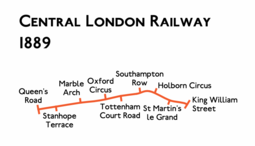中央倫敦鐵路

中央倫敦鐵路(英語:Central London Railway,CLR),又被称为“两便士地铁”(英語:Twopenny Tube[註 1]),是倫敦歷史上一条深层地铁线路,其路線相當於今日倫敦地鐵的中央線中部部分。
倫敦中央鐵路公司設立於1889年。在于1895年成功筹资后,中央線於1896年至1900年间完成施工。1913年,倫敦中央鐵路被倫敦地鐵公司收購。开通初期的中央铁路长达9.14公里(5.68英里)全部区间都位于地下,而且是复线铁路;全程共有13个车站,西起牧羊丛,东至英格兰银行,而车辆段和供电站则位于西端终点站的北边[1]。在改建为环线的计划被否决后,本线在1908年向西延长到了伍德巷站,又在1912年延长到了利物浦街车站。到1920年,本线又沿着大西部铁路延长到了伊灵,里程也增加到了17.57公里(10.92英里)[1]。
中央伦敦铁路 | |||||||||||||||||||||||||||||||||||||||||||||||||||||||||||||||||||||||||||||||||||||||||||||||||||||||||||||||||||||||||||||||||||||||||||||||||||||||||||||||||||||||||||||||||||||||||||||||||||||||||||||||||
|---|---|---|---|---|---|---|---|---|---|---|---|---|---|---|---|---|---|---|---|---|---|---|---|---|---|---|---|---|---|---|---|---|---|---|---|---|---|---|---|---|---|---|---|---|---|---|---|---|---|---|---|---|---|---|---|---|---|---|---|---|---|---|---|---|---|---|---|---|---|---|---|---|---|---|---|---|---|---|---|---|---|---|---|---|---|---|---|---|---|---|---|---|---|---|---|---|---|---|---|---|---|---|---|---|---|---|---|---|---|---|---|---|---|---|---|---|---|---|---|---|---|---|---|---|---|---|---|---|---|---|---|---|---|---|---|---|---|---|---|---|---|---|---|---|---|---|---|---|---|---|---|---|---|---|---|---|---|---|---|---|---|---|---|---|---|---|---|---|---|---|---|---|---|---|---|---|---|---|---|---|---|---|---|---|---|---|---|---|---|---|---|---|---|---|---|---|---|---|---|---|---|---|---|---|---|---|---|---|---|
| 截至1933年,移交LPTB前。 | |||||||||||||||||||||||||||||||||||||||||||||||||||||||||||||||||||||||||||||||||||||||||||||||||||||||||||||||||||||||||||||||||||||||||||||||||||||||||||||||||||||||||||||||||||||||||||||||||||||||||||||||||
| |||||||||||||||||||||||||||||||||||||||||||||||||||||||||||||||||||||||||||||||||||||||||||||||||||||||||||||||||||||||||||||||||||||||||||||||||||||||||||||||||||||||||||||||||||||||||||||||||||||||||||||||||
建造过程
[编辑]筹划(1889–1892)
[编辑]
1889年11月,中央伦敦铁路发布了一份关于私人法案的告示。相关法案随后被展示于1890年的议会立法期间[2]。法案建议修建一条地下电气化铁路;线路两端起点分别位于贝斯沃特里的皇后路和贝斯沃特路口和伦敦城里的威廉王街,经过贝斯沃特路、牛津街、霍本高街、霍本、霍本高架橋、纽盖特、齐普赛街和家禽街,并连接当时还在施工的城市及南伦敦铁路(C&SLR)。车站则分别位于皇后路、大理石拱门、牛津圆环、托特纳姆宫路、南安普顿道、霍本圆环、圣马丁大道和威廉王街地下[3]。
隧道的设计直径为11英尺(3.4米),由盾构机开凿,再由铸铁板砌成;在车站区域,隧道的直径会根据设计,在22英尺(6.7米)和29英尺(8.8米)之间变化。变电站和车辆段则选址在皇后路西侧的一个1.5英畝(0.61公頃)的空地处。每个车站都将有从街面到地下站台的液压电梯[4]。
然而,此计划遭到了多方的反对。
- 大都会铁路和区域铁路的反对最为强烈。由于中央铁路的走向与内环线[註 2]相近,两家公司担心客流量会被分流。
- 伦敦市法团担心施工会像C&SLR的建造一样,再次引起沉降,并影响路线周围的建筑。
- 圣保罗座堂的主任牧师和教士们担心施工会损毁教堂的地基。
- 约瑟夫·巴扎尔杰特爵士担心隧道会损坏城市的排水系统。
最后法案虽然在下议院通过,却被上议院否决。上议院建议推迟表决,直到C&SLR开通,其运营情况得到评估之后。[5]

1890年11月,C&SLR开通后,CLR向次年的立法期间提交了一份新的法案[6]。同时,线路西端也延长至牧羊丛的东侧并经过诺丁山门和荷兰公园大道,而车辆段和供电站也改为伍德路的东侧、终点站的北端。该线路西端被延长后可以运营到诺丁山高街即现在的诺丁山门站和荷兰公园大道站下,最后到Shepherd's Bush即现在的Shepherd's Bush Green的东边角落。线路的车库和电站北重新安置在了Wood Lane站东边作为北方终点。
The route was extended at the western end to run under Notting Hill High Street (now Notting Hill Gate) and Holland Park Avenue to end at the eastern corner of Shepherd's Bush Green, with the depot and power station site relocated to be north of the terminus on the east side of Wood Lane. The westward extension of the route was inspired by the route of abandoned plans for the London Central Subway, a sub-surface railway that was briefly proposed in early 1890 to run directly below the roadway on a similar route to the CLR.[7] The eastern terminus was changed to Cornhill and the proposed Southampton Row station was replaced by one in Bloomsbury. Intermediate stations were added at Lansdowne Road, Notting Hill Gate, Davies Street (which the CLR planned to extend northwards to meet Oxford Street) and at Chancery Lane.[8] The earlier plan to connect to the C&SLR was dropped and the diameter of the CLR's tunnels was increased to 11英尺6英寸(3.51米).[7] This time the bill was approved by both Houses of Parliament and received Royal Assent on 5 August 1891 as the Central London Railway Act, 1891.[9] In November 1891, the CLR publicised another bill. The eastern end of the line was re-routed north-east and extended to end under the Great Eastern Railway's (GER's) terminus at Liverpool Street station with the Cornhill terminus dropped and a new station proposed at the Royal Exchange.[10] The proposals received assent as the Central London Railway Act, 1892 on 28 June 1892.[11]

The money to build the CLR was obtained through a syndicate of financiers including Ernest Cassel, Henry Oppenheim, Darius Ogden Mills, and members of the Rothschild family.[12] On 22 March 1894, the syndicate incorporated a contractor to construct the railway, the Electric Traction Company Limited (ETCL), which agreed a construction cost of £2,544,000 (approximately £3.08億 today)[13] plus £700,000 in 4 per cent debenture stock.[14] When the syndicate offered 285,000 CLR company shares for sale at £10 each in June 1895,[14] only 14 per cent was bought by the British public, which was cautious of such investments following failures of similar railway schemes.[15] Some shares were sold in Europe and the United States, but the unsold remainder was bought by members of the syndicate or by the ETCL.[14]
建造(1896–1900)
[编辑]参考文献
[编辑]- Badsey-Ellis, Antony. London's Lost Tube Schemes. Capital Transport. 2005. ISBN 1-85414-293-3.
- Bruce, J Graeme; Croome, Desmond F. The Central Line. Capital Transport. 2006 [1996]. ISBN 1-85414-297-6.
- Connor, J E. London's Disused Underground Stations. Capital Transport. 2006 [1999]. ISBN 1-85414-250-X.
- Day, John R; Reed, John. The Story of London's Underground. Capital Transport. 2008 [1963]. ISBN 1-85414-316-6.
- Emmerson, Andrew; Beard, Tony. London's Secret Tubes. Capital Transport. 2004. ISBN 1-85414-283-6.
- Horne, Mike. The District Line. Capital Transport. 2006. ISBN 1-85414-292-5.
- Lee, Charles Edward. Seventy Years of the Central. Westminster: London Transport. May 1970. ISBN 0-85329-013-X. 570/1111/RP/5M.
- Rose, Douglas. The London Underground, A Diagrammatic History. Douglas Rose/Capital Transport. 1999 [1980]. ISBN 1-85414-219-4.
- Wolmar, Christian. The Subterranean Railway: How the London Underground Was Built and How It Changed the City Forever. Atlantic Books. 2005 [2004]. ISBN 1-84354-023-1.
- ^ 1.0 1.1 Clive's Underground Line Guides, Central line, Layout. Clive D. W. Feathers. [2010年3月30日]. (原始内容存档于2019年4月3日).
- ^ 第25996號憲報. 倫敦憲報. 26 November 1889.
- ^ Badsey-Ellis 2005,第43頁.
- ^ Badsey-Ellis 2005,第44頁.
- ^ Badsey-Ellis 2005,第44–45頁.
- ^ 第26109號憲報. 倫敦憲報. 25 November 1890.
- ^ 7.0 7.1 Badsey-Ellis 2005,第47頁.
- ^ Day & Reed 2008,第52頁.
- ^ 第26190號憲報. 倫敦憲報. 7 August 1891.
- ^ 第26227號憲報. 倫敦憲報. 27 November 1891.
- ^ 第26303號憲報. 倫敦憲報. 1 July 1892.
- ^ Wolmar 2005,第147–148頁.
- ^ 见英国零售价指数,数据来自Clark, Gregory. The Annual RPI and Average Earnings for Britain, 1209 to Present (New Series). MeasuringWorth. 2017 [2022-06-11].
- ^ 14.0 14.1 14.2 Bruce & Croome 2006,第5頁.
- ^ Wolmar 2005,第147頁.